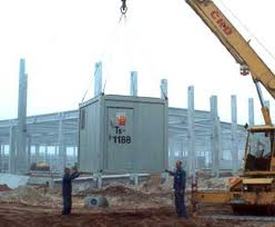
The concern for fire hazards here is reduced because of the outdoor location; however, the hazard is not eliminated, and you must take the following precautions.
Less-flammable liquid-insulated transformers. The requirements for these installations can be found in Sec. 450-23. Transformers meeting the less-flammable class requirements can be installed outdoors attached to, adjacent to, or on the roof of Type I and Type II buildings, as shown in Fig. 3. (Type I and II building constructions are classified as noncombustible construction and can be further investigated in NFPA/ANS1220-1995, Types of Building Construction. Local building codes such as BOCA, ICBO, SBCCI, etc. also may influence the determination of building construction type.)
Less-flammable liquid-insulated transformers have requirements for additional safeguards if they are installed outdoors on, attached, or adjacent to buildings not meeting Type I or Type II constructions, or if they are adjacent to combustible materials. These additional safeguards are not clearly spelled out in the NEC, but some guidance is given. You should discuss this with the local authority having jurisdiction. Fire barriers, space separation, and compliance with the liquid listing requirements are all recognized safeguards in the NEC.
Fire barriers generally consist of 1-hr fire-rated materials and may be one-, two-, three-, or four-sided, depending upon the arrangements of the transformer to the occupancy. [ILLUSTRATION FOR FIGURE 4 OMITTED].
Space separation, as shown in Fig. 5, is a requirement based on the relative separation of the transformer from the building or combustible materials. To determine the proper space separation, you have to evaluate the amount of liquid and its particular heat-producing characteristics. Factor Mutual (FM) has performed such evaluations and provides recommended clearances for the various types of transformers.
Compliance with the liquid listing requirements: Basic details regarding the listing agency requirements are discussed later.
The NEC also requires that similar safeguards to the ones discussed above be taken if the transformer is located adjacent to fire escapes or door/window openings. The intent with this precaution is to ensure that adequate means of egress from the building is provided if the transformer is in a failure mode.
Sec. 450-24 covers this class of transformer for outdoors installations as well. No special requirements exist for these transformers installed outdoors. They must be designed and constructed to absorb any gases generated by arcing inside the tank, or the pressure relief vent must be vented to an environmentally safe area.
Oil-insulated transformers. Sec. 450-27 of the NEC is specifically dedicated to these transformers installed outdoors. The NEC does not provide any special requirements for these transformers if they are installed adjacent to, attached to, or on the roof of a building of noncombustible construction (except when installed close to doors, windows, or means of egress). However, good engineering judgment should be used when installing in these locations.
Oil-filled transformers can have failures resulting in a transformer fire, and the potential impact of that fire on the building should be evaluated. The heat convection and radiation rates of the oil should be reviewed and compared with the ability of the building construction to handle the heat released during a fire. Some guidance to this type of evaluation is provided in the "Listing Requirements" section of this article, on page 80. Also, you should reference IEEE 979-1992, Guide For Substation Fire Protection.
Additional information can be obtained from insurers for guidance. FM, for instance, gives a number of reasonable guidelines for these transformers where they are installed adjacent to a building.
For other situations, the NEC requires that "combustible materials, combustible buildings, parts of buildings, fire escapes, and door and window openings shall be safeguarded from fires originating in oil-insulated transformers installed on roofs, attached to, or adjacent to a building or combustible material."
The recognized safeguards, as shown in Fig. 6 (on page 79), are space separations, fire-resistant barriers, automatic water spray systems, and enclosures that confine the oil of a ruptured tank.
(by Loyd, Richard E)
to be continue...

 RSS Feed
RSS Feed


